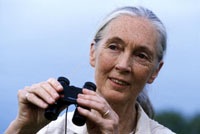It’s a rare person who can make important scientific discoveries, drive significant social change, and break down gender barriers—all while becoming a household name.
Jane Goodall is such a person. As a young child, she dreamed of experiencing the geography of Africa. And she’s a woman who has lived her dream. She set off to Gombe, Tanzania, and studied chimpanzees there for more than 50 years. What she found not only defined the first half of her career but also redefined humankind.

Changing Geography
Geography is constantly changing—from wind and water erosion, natural climate shifts, tectonic and volcanic activity, and the dominance and extinction of species and ecosystems. But recent changes to geography as a direct result of human activities are threatening the survival of many species, including our own. And while the actions causing these monumental changes are often deliberate, much of the change to geography has been an unintentional by-product of poor planning and unsustainable actions—change that I call “accidental geography.”
Jane saw this herself when she returned to her beloved Gombe in the 1990s and noticed the overwhelming impact humans were having on the ecosystem. This impact was not just threatening the existence of the chimpanzees but also threatening the health and well-being of the people creating the impacts. She realized that, to improve the lives of animals, she must first figure out how to improve the lives of humans.
Modern humans are in an odd position: we are the root cause of many of these changes, yet we also hold in our hands the keys to halting and even reversing the process. So how can we move away from this accidental geography and move toward what Harvard professor Carl Steinitz has called “changing geography by design”?
Take Care
The second half of Jane’s career has been defined by education, outreach, and building awareness. She has successfully taken the skills and techniques learned in the first half and broadened their impact through the creation of new outreach programs such as Roots and Shoots and the Lake Tanganyika Catchment Reforestation and Education (TACARE or “Take Care”) program. This is how she went from studying chimpanzees in a tiny valley in Africa to creating an approach to conservation that just might change the world.
The Jane Goodall Institute (JGI) launched TACARE in 1994. This community-centered conservation and development program partners with local inhabitants to create sustainable livelihoods while promoting environmental protection. TACARE achieves conservation results by first consulting communities about their needs and priorities, working together to collaboratively design the future rather than imposing outside solutions.
Jane and I share a deep belief in the interconnectedness of all things, which obligates humankind to protect and conserve the environment. I believe TACARE is the way forward for addressing many of our planet’s most pressing problems. TACARE is a methodology for planning, policy, and technology working hand in hand to take care of geography.
Changing the World Together
Esri has partnered with JGI to help share the innovative TACARE approach at a global scale. Applying this approach as individuals can help us make a difference in countless areas; but I believe that working together, TACARE will help us design a better world.
TACARE is Jane’s vision of how the world could be a better place. She has learned from years of experience in the field that this can only happen when the physical, biological, and cultural aspects of geography are addressed holistically.
Related Content:
- From Maps to GeoDesign: Conserving Great Ape Landscapes in Africa, ArcNews, Summer 2011
- Harnessing the Power of Our GeoDesign Vision, ArcNews, Summer 2011
